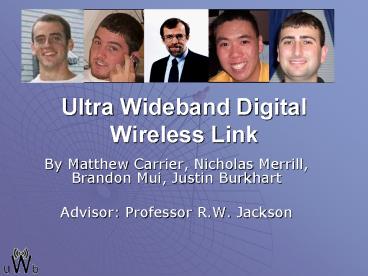Ultra Wideband Digital Wireless Link - PowerPoint PPT Presentation
1 / 12
Title:
Ultra Wideband Digital Wireless Link
Description:
Ultra Wideband Digital Wireless Link By Matthew Carrier, Nicholas Merrill, Brandon Mui, Justin Burkhart Advisor: Professor R.W. Jackson What is Ultra Wide Band? – PowerPoint PPT presentation
Number of Views:179
Avg rating:3.0/5.0
Title: Ultra Wideband Digital Wireless Link
1
Ultra Wideband Digital Wireless Link
- By Matthew Carrier, Nicholas Merrill, Brandon
Mui, Justin Burkhart - Advisor Professor R.W. Jackson
2
What is Ultra Wide Band?
- Ultra Wide Band (UWB) uses very low-powered,
short pulsed radio signals to transfer data over
a wide range of frequencies - FCC Definition
- Signals must occupy bandwidth gt500MHz
- Or, signal bandwidth is 20 of the carrier
frequency
3
Why do we need Ultra Wide Band?
- High-tech designs require portability, speed,
performance - Portability
- UWB use multiple low-powered pulses ? low power
consumption - UWB data rate is inversely proportional to
distance (thus short range) - Speed
- Proposed to be between 40-600 Mb/s, and
eventually up to Gb/s - Performance
- Volume of information proportional to the
frequency band - More information ? better graphics, better
resolution for RADAR, etc.
4
Transmitted Reference UWB Systems
- Standard TR-UWB systems are dogged by
implementation issues - The receiver requires an extremely wideband delay
element - As a solution, Professor Goeckel has developed
theory for Slightly Frequency Shifted Reference
UWB
5
Slightly Frequency Shifted UWB
- Rather then separating the data from the
reference in time, this systems separates them in
frequency - Data and Reference pulse must be orthogonal in
frequency - This avoids using the extremely wideband delay
element in the receiver - Our project is to take Prof. Goeckels theory and
prove the concept through building a scaled
prototype
6
Deliverables
- Transmitter/Receiver Electronics Prototype
- Transmitter/Receiver Antenna Prototype
- Packaging design is not part of project
7
Transmitter
PLD
Input
X
S
Pulser
Oscillator
X
- Omni antenna
- Pulse Generator has pulses with picosecond rise
times - Oscillator used for frequency shifting of the
pulses - PLD is used for buffering of data
8
Receiver
Integrator
X
PLD
X
Oscillator
- Omni antenna
- Oscillator at same frequency and phase as
transmitter (sync not yet designed) - PLD is for out-buffering of received data
9
What is Missing?
- Need to design circuitry to synchronize the
frequency shift oscillators - Need to develop/buy integrator circuitry that can
be triggered - Integrator and PLD sampling also have sync issues
that need to be worked out - Antenna design has yet to be implemented
- An antenna in our channel has already been
designed by grad students here at UMASS
10
Pulse Generation Closer Look
- Create very fast pulses using Step Recover Diodes
(SRD)
11
MDR Specification
- Transmitter Receiver prototype built
- Built using modular components connected with
coaxial cable - No synchronization circuitry implemented
- No antenna implemented
- Antenna design prototype built
- Tested for gain, return loss, radiation
patterns - Synchronization Circuitry
- Will be designed independently from the prototype
12
Questions/Suggestions?
?































